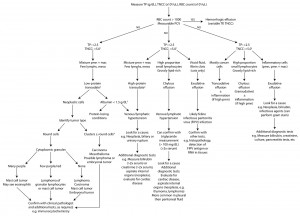Interpretation of peritoneal and pleural fluid is based on a combination of cytologic assessment of smears, total protein (by refractometer) results, nucleated cell and red blood cell (RBC) counts. There are three main mechanisms for an effusion: transudation (alterations in hydrodynamic forces), exudation and vessel/viscus rupture or leakage.
Note that the RBC count may be high from blood contamination (expect to see platelets in smears, if sufficient blood, sample will clot in a red top tube) or hemorrhage (expect to see no or few platelets, erythrophages, hemosiderophages and hematoidin crystals [in a hypoxic environment], if sufficient blood, sample will not clot in a red top tube) or diapedesis. Hemorrhage can complicate effusions from other causes (usually exudative) and cannot be differentiated from diapedesis (due to transudation).
1 Total nucleated cell counts do not equal leukocytes, because the count also include neoplastic or mesothelial cells and in cases of enterocentesis, bacterial clumps and food debris. Thus counts should never be used alone to classify effusions and cytologic assessment should always be performed.
2 Classification of fluid as a low or high protein transudate is usually only done for peritoneal fluid, with leakage of low protein intestinal lymph (lymphangiectasia, portal hypertension) resulting in a low protein transudate and leakage of high protein hepatic lymph (sinusoidal or post-sinusoidal hypertension) in a high protein transudate. This distinction is not meaningful for pleural fluid.
3 Low albumin (<1.5 g/dL) alone is an uncommon cause of a low protein transudate, but can be seen in cats and dogs with severe protein-losing nephropathy. Usually, an effusion in an animal with low albumin is caused by concurrent venous or lymphatic hypertension or obstruction.
4 Clusters and individual large round cells in a fluid can be mesothelial cells (reactive or neoplastic) or from round cell tumors (e.g. lymphoma). We have also seen primitive embryonal tumors (nephroblastoma, Ewing’s sarcoma) exfoliate as individual cells with small adherent clusters, mimicking a carcinoma.
TP: Total protein by refractometer, TNCC: Total nucleated count, RBC: Red blood cell count, PCV: Packed cell volume, PMN: Neutrophils, Mac: Macrophages, Meso: Mesothelial cells, FIPV: Feline infectious peritonitis virus.

